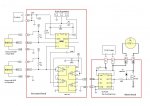Im still not sure how that will work with the OP motor as he needs to turn the coil off and on during each rev, while monitoring the hall sensor at the same time.
Post 237 you commented on switching each coil seperate (bit like a stepper motor), this would make the timing even harder to control the coil duty cycle with the circuit used.
Dont get me wrong as i had thought of these methods too, but kept finding problems with how the picaxe could manage all functions with correct timing without effecting each other function.
Then concluded that the willingness to make changes to the circuit or changes to components used was not a option the OP wanted to do, so its like flogging a dead horse, it aint going anywhere.
Post 237 you commented on switching each coil seperate (bit like a stepper motor), this would make the timing even harder to control the coil duty cycle with the circuit used.
Dont get me wrong as i had thought of these methods too, but kept finding problems with how the picaxe could manage all functions with correct timing without effecting each other function.
Then concluded that the willingness to make changes to the circuit or changes to components used was not a option the OP wanted to do, so its like flogging a dead horse, it aint going anywhere.

